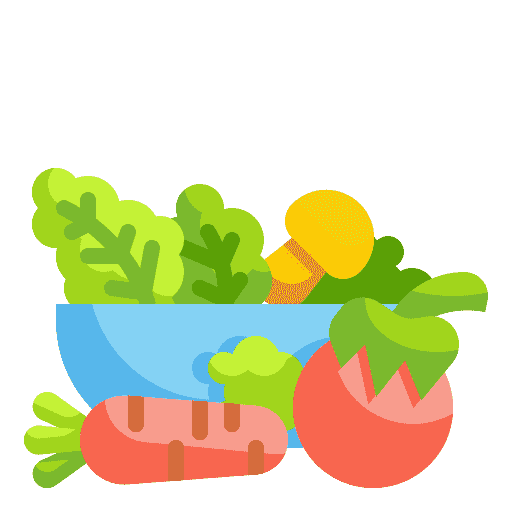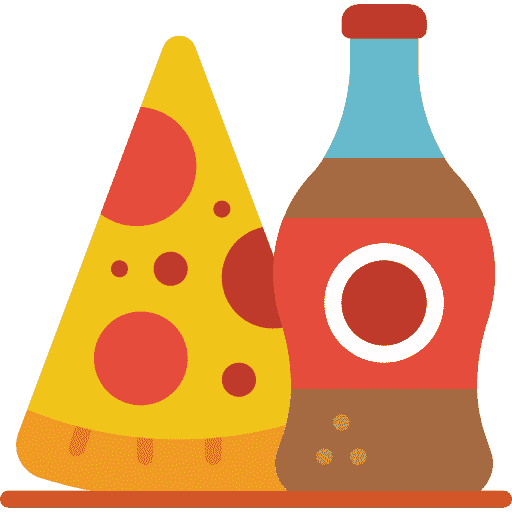In our globalized, highly-technological world, food can be found in all kinds of shapes and forms.
Indeed, with the help of the different food processing methods currently available, it'd seem that food can be made to be as durable, convenient, nutritious and palatable as we want it to be.
However, these processing methods are not all created equal, and some of them can even have devastating impacts on our environment and health.
Because of that, it makes sense for us to talk a bit about food processing and the different foods it produces, so that we can choose and prepare food more wisely to derive much of its benefits with minimal risk.
Minimally-processed vs. Highly-processed Food
To be sure, all foods — even the so-called "raw foods" — are processed in one form to another. It often happens after it's known under the name of the food, but it can also happen before it's known under that name as well.
But even so, not all foods are processed the same way to the same degree. This is why we often like to segment foods by their processing intensity, and to make a distinction between the following two food categories:

Minimally-processed Food
Food which has undergone some minimal physical alterations to render it into a safe, edible form, and which retains most of its appearance and chemical structure.

Highly-processed Food
Food which has undergone substantial physical and chemical alterations, and which differs from its original form in terms of chemistry, taste, durability and appearance.
And with this, we now have a simple tool of tackling the nuances of food processing — without having to indiscriminately put everything into the same basket.
The Pros and Cons of Food Processing
Throughout history, humans have been processing food through a wide range of processing methods. For the most part, these methods can be put into three categories as follows:
While food processing (and the related concept of processed food) can be perceived negatively, it is also sometimes a necessary step to ensure that the food we consume is safe and healthy. For example:
Indeed, without food processing, it would be hard for us to imagine how we can continue to consume staple foods such as meat, fish, seafood, eggs, tubers, grains and beans — without compromising our health and our body.
And just as we often process food out of basic necessities (in conformity with the principle of minimalism), we also often process food for the sake of improving its quality. For example:
But then, not all food processing methods are created equal, and it's definitely possible for us to process our food a bit more than needed. In fact, when our food is highly processed:
This means that while food processing at a minimal level can indeed be life-changing, there is also a point at which the more we process our food, the less it is recognized by our body (and the more we subject ourselves to unnecessary risks).
In fact, it wouldn't be unfair to say that in this day and age, heavy food processing is now becoming a hindrance to sustainability, with the food it produces being responsible for much of the environmental and health problems we're seeing today.
So that even if highly-processed foods are often superior in terms of shelf life, texture and palatability, by choosing minimally-processed foods altogether, we can often end up with foods that are generally safer, fresher and more nutritionally rich.
Methods of Food Processing
As one would expect, food processing can happen anywhere within the food production/consumption process (e.g., from farm to table). These processes can be applied before production, before cooking, during cooking or even after cooking.
Pre-production Processes
Pre-production processes are processes which, while usually not regarded as part of "food processing", can nevertheless affect the quality of food significantly. In some cases, these processes can even occur before the produces are harvested.
Selective Breeding
Much like the way we domesticate plants and animals, we also often produce food by selectively breeding organisms whose traits are to our liking. This practice is known as selective breeding, or artificial selection under the language of Charles Darwin.
While selective breeding often leads to produces that are more palatable, high-yielding and disaster-resistant, the food in question can also be nutritional inferior to its wilder counterpart (e.g., banana vs. plantain, corn vs. wild maize).
Genetic Modification
Genetic modification is a targeted method for introducing desirable traits to crops or food by altering their DNA structure. Food produced this way includes delay-ripening tomato, genetically-engineered salmon, soybean, corn and seedless fruits.
While genetic modification can endow an organism with better taste and more resistance to drought, herbicides and pathogens, its usage remains controversial due to various factors related to the environment, farming and human health.
Synthetic Fertilization
A remnant of the Green Revolution, synthetic fertilization refers to the process of using synthetic substances (e.g., nitrogen/phosphorus fertilizers, recycled industrial wastes) to enhance the quality of the soil.
While synthetic fertilization can be used to greatly improve a crop's productivity, Its overuse can also lead to soil depletion and acidification (among other environmental problems), leading to food that is generally blander in taste and poorer in nutrition.
"Accidental" Processing
"Accidental" processing refers to the addition of substances which sometimes improve the economic value of food — but which are unwanted within the food itself. These substances include, among others:
For the most part, these substances are harmful to the human body when exposed chronically in large quantities, though it is also possible to minimize their exposure by consuming food produced through organic means.
Pre-cooking Processes
Pre-cooking processes are processes which are responsible for turning raw materials into food ingredients. Processing methods in this category are often time-tested and mechanical in nature — with a few exceptions.
Cleaning
Methods that remove harmful compounds from food ingredients often fall within this category. These include methods such as:
While most of these methods are relatively safe, they can also alter food substantially when used intensely. For example:
Mechanical Refining
Mechanical refining refers to methods which break food ingredients from large chunks into smaller, more digestible pieces. Methods in this category include, among others:
While many of these methods are used and adopted throughout generations, the more refined versions of these methods can also introduce unwarranted risks to the food itself. For example:
Filtering
Methods aimed at removing unwanted components from food ingredients often fall within this category. These include methods such as:
While much of these methods are mechanical by nature, the very act of filtering can also prevent one from consuming food as a whole (which can lead to nutrient loss or nutrients being absorbed at a faster rate).
Liquid Immersion
Liquid immersion refers to methods whereby food ingredients are placed in a liquid for a significant period of time. These methods include, among others:
While many of these methods can be used to "bring out the best of food", when pushed to the extreme, they can also break food down excessively, leading sanitary and health concerns such as rancidity, contamination and elevated blood sugar.
Cooking Processes
Cooking in general refers to the different methods of using heat to turn food ingredients into food. Prominent cooking methods often involve the heating of liquid, air or oil.
Liquid-based Methods
Cooking methods based on immersing food ingredients into heated liquid fall into this category. These include, among others:
For the most part, liquid-based cooking methods are time-tested methods for increasing the safety and editability of food: it makes our food less prone to foodborne diseases, while at the same time enhancing its nutrient bioavailability and palatability.
However, when carried out at a high temperature for a long duration, these methods can also degrade the food's nutritional profile, leading to loss of "fragile nutrients" such as minerals and vitamins.
Air-based Methods
Cooking methods based on heating through air (often in an oven-like setting) fall into this category. These include methods such as:
Because many of these methods can operate beyond water's boiling point, foods produced these ways tend to be relatively rich in flavors and smells.
However, the same reason can also mean that these methods are highly prone to overcooking, which in turn can introduce carcinogens and glycation products into our body.
Oil/Alcohol-based Methods
Cooking methods which involve the use of oil or alcohol fall into this category. These include methods such as:
Since these methods combine contact-based heating along with substances that heat up very quickly, foods prepared these ways are often highly palatable and crunchy.
However, the same reasoning also means that these foods can be more inflammatory and more prone to being overcooked — than if a liquid-based cooking method were used.
Refining Processes
Refining refers to a series of industrial/near-industrial processes which lead to a significant alteration in food, resulting in changes in the food's appearance, taste, shelf life or chemical structure.
Chemical Extraction
Chemical extraction involves the extraction of ingredients through some chemical means. A prominent example of this occurs in the production of vegetable oils, which are often extracted from seeds via a process known as hexane extraction.
And since hexane is a petroleum-based toxin, vegetable oils produced this way (e.g., canola oil, soybean oil, corn oil, sunflower oil) can run the risk of being contaminated by hexane residues.
Hydrogenation
Hydrogenation is a form of chemical engineering which turns liquid fat into a solid/semi-solid form. Fats formed this way are also called industrial trans fats, and are often found in margarine and other pre-made processed food.
While hydrogenated fat has the benefit of being more resistant to oxidation and spoilage, its consumption is also linked with a wide range of chronic conditions such as cardiovascular diseases and obesity.
Fortification
Fortification, or nutritional enrichment, is the process of adding micronutrients such as vitamins and minerals to food. Prominent fortified foods include dairy products and cereal-based products.
While fortification is often done to restore the nutrients lost during the production process, the added nutrients are often synthetic isolates that are not very well absorbed by the body (e.g., vitamin D in skim milk).
And while some fortified foods can indeed play a role in addressing certain dietary deficiencies in the general population, their skewed nutritional profile can also make them an object of concern in terms of food safety.
Extrusion
Extrusion is a method which forces soft food ingredients into an opening — so as to mold them into a desired form. Common foods produced this way include processed starches such as noodles, bread, snacks, desserts and cereals.
Since extrusion often involves high-temperature heating and a series of chemical reactions, extruded foods are often highly denatured and more sugary than their original counterpart.
Coating
Coating is the process of applying a layer of liquid or solid onto food — so as to improve its appearance, flavor or texture. Prominent foods which are often coated include, among others:
While coating in theory needs not be a bad thing, the materials used in industrial coating — such as salt, syrup, artificial flavor, artificial seasoning and batter — are usually not very conducive to health.
Addition of additives
In food manufacturing, many substances are often added to food to endow them with certain desirable properties. These substances are known as food additives, of which many types exist:
In general, food additives are often added to foods devoid of fiber, vitamins and minerals, and are often controversial due to their nebulous cumulative effects on human health.
Preservation Processes
To preserve the quality of food for a significant period of time, various preservation methods are often used. The following includes some of the most notable ones, along with their benefits and drawbacks.
Drying
Drying is a historically viable method of reducing the rate at which food spoils. Prominent methods of drying include sun drying, evaporation and freeze-drying.
When combined with salt or sugar (as in the curing of meat or the soaking of fruits in honey), drying can be doubly effective in drawing out water molecules from food, which in turn prevents its oxidation and microbial growth.
Cooling
Cooling is another time-tested way of preserving food that operates by slowing down the growth of microorganisms and the activity of enzymes. Prominent methods of cooling include, among others:
In general, the longer and cooler the food is stored, the longer it can be preserved. However, intense cooling is not always the ideal method for preserving food, as it can lead to loss of micronutrients and change of texture as well.
Heating
Similar to cooling, heating is a common food preservation method which operates by destroying the bacteria responsible for spoilage. Prominent methods of heating (in the context of food preservation) include, among others:
In general, the longer and hotter the food is heated, the longer it can be preserved. However, intense heating is rarely the ideal method for preserving food, as it can result in nutrient loss and change in chemical composition as well.
Addition of Preservatives
Preservatives are substances of natural/artificial origin which are added to food to prevent oxidation and microbial growth. Prominent preservatives include, among others:
While artificial preservatives tend to be better at preserving food for a longer duration, their foreign nature can also be a source of concern. Sodium nitrate, for instance, has been linked to a series of neurological diseases and cancers.
Food Irradiation
Food irradiation refers to the use of ionizing radiations (e.g., x-rays, gamma rays, certain UV rays) to minimize spoilage bacteria without any physical contact. Examples of irradiated food include packaged meat, shellfish and pre-packaged food.
Despite its association with radiation, food irradiation cannot make a food product radioactive. In fact, it is generally considered to be safe by most government agencies, even though whether it constitutes a sustainable technology is yet to be determined.
Pulse Electric Field Processing
A relatively new technology, pulse electric field (PEF) processing is a method of food preservation which operates by subjecting food to short electrical pulses. PEF processing has some applications in the treatment of juices and potatoes.
Since PEF processing does not require heating or physical contact with food, it can be used to halt microbial activities with minimal alteration to food. However, the method as it stands is still limited in scope, and whether it is sustainable is still up for debate.
Packaging Processes
Packaging processes refer to the various methods of enclosing food which allow it to be transported with minimal loss in quality. The more effective the packaging, the better it is at minimizing the risks of contamination, damages and loss of freshness.
Cartoning
Cartoning is the process of enclosing food in cartons for preservation and transportation purposes. The cartons being used can include, among others:
While much of the cartons being used for food packaging are non-toxic and recyclable, not all cartons are biodegradable (not to mention that excessive packaging can also contribute to a significant amount of wastes in the landfill).
Bag Packaging
Bag packaging is the practice of enclosing food in bags for preservation and transportation purposes. The actual bags being used can come in different types, which include, among others:
In some cases, manufacturers might also employ vacuum packing to strip oxygen out of the bag and extend the food's shelf life. However, doing so can also change the flavor of the food that is inside.
And while bags are in general a safe and reliable way of packaging food, much of bag packaging is done with plastic, which comes with its own sanitary and environmental risks.
Bottling
Bottling is the process of placing food and beverages in bottles to ensure that they can be transported with minimal loss in quality. For this, three types of materials are often used:
While bottling is in general a reliable way of packaging food, when liquid food is bottled in plastic or aluminum, the leaching of chemicals into food (e.g., microplastics, xenoestrogens) can be a source of concern as well.
Canning
Canning is the process of storing food in airtight cans to endow it with a substantially longer shelf life. Prominent foods that are often sold in canned form include tuna, oyster, tomato soup and syruped fruits.
While canned foods can have a relatively well-preserved nutritional profile, they are also often heavily treated before being canned — and might even contain salt, preservatives, heavy metals or bisphenols as residues.
Categories of Highly-processed Foods
From the various processing methods mentioned above, you might notice that highly-processed foods often come with the following characteristics:
Because of that, it shouldn't be surprising that these foods are also often linked to chronic conditions such as:
However, one thing that is also interesting about these foods is that they can be succinctly summarized in three categories: high-fat, high-sugar and high-salt. Here's a chart summarizing the foods commonly found in these categories:
High-Fat Foods
Fast Food
Processed Meat
Processed Dairy
Processed Oils
High-Sugar Foods
Artificial Sweets
Flour-based Foods
Sweeteners
Denatured Starch
Artificially-selected Produces
Processed Beverages
High-Salt Foods
Categories of Minimally-processed Foods
Unlike highly-processed foods, minimally-processed foods tend to retain a large part of their original appearance, and are often produced sustainably with minimal extraneous risks. The following chart includes some of its most prominent categories.
Eggs

Examples
One of the few animal foods that is of relatively low risk (due to their natural shelling), eggs based on free-range pasture and organic practices tend to be more nutritious and less contaminated when minimally cooked.
Tubers

Examples
Large-size root/stem vegetables that are often high in complex carbohydrates, tubers are best eaten as a whole after the application of some light cooking methods (such as stewing and steaming).
Nuts

Examples
Dried fruits and seeds that are relatively clean and energy-dense, nuts are best consumed unadulterated as a whole (e.g., unsalted, unsweetened, unfried) to minimize the risks of inflammation and contamination.
Legumes

Examples
Small-size seeds of plants that are high in complex carbs and protein (and whose cultivation does not require nitrogen fertilizers), legumes can be a clean, wholesome source of nutrients when moderately stewed.
Fruits

Examples
Ripen by-products of plants that are often sweet or sour, organically-produced fruits that are closer to their wild progenitors tend to be healthier and less contaminated when eaten raw.
Vegetables

Examples
Generally known for their micronutrients and anti-inflammatory properties, organic vegetables procured locally in an uncanned, unpackaged form tend to better at mitigating the risk of contamination when eaten raw.
Simple Drinks

Examples
Drinks that involve a minimal amount of processing, these beverages tend to be less stimulating (e.g., low in sugar and salt) and less prone to contaminations than their industrial counterparts.
In essence, minimally-processed foods are often such that they require little to no industrial processing to improve their quality. Because of that, they often occupy the bulk of the so-called traditional diets (such as the ones found in the Blue Zones).
Procedure for Choosing and Processing Food
So far, we've seen the different types of food processing and the different categories of food that they produce. However, it's also one thing to know about them in theory — than to actually apply them in practice.
In fact, the pursuit towards minimally-processed food is all about changing the way we procure food — and how we prepare it. To aid you in the process, here's a practical 7-step procedure you can use every day to move towards that goal:
As this procedure shows, food processing is often more subtle than can be revealed by color codes and nutritional labels. Because of that, the ability to visualize the food's journey from its source to the table is often useful.
And while having a process for filtering out the more nefarious forms of processing can help, it's just as important to develop a healthy feeding habit and a healthy attitude towards food processing as well. In particular, one should note that:
After all, the search for minimality here does not call for the least amount of processing in the absolute terms. Rather, it is to be interpreted within the confine of our nutritional demands and other long-term goals.
And while minimally-processed foods might not be as durable/palatable as their more processed counterparts, by opting out of our complex industrial food system, we can also avoid the many unwarranted risks that can compromise our planet and our health.

